GPA Calculator
Track your academic progress and achieve your best GPA
Use our free but accurate calculator that can calculate your GPA in no time and help you track your academic journey more smartly.
| # | Course | Grade | Credits | Action |
|---|---|---|---|---|
| 1 |
If you have grades in different formats, letter, percentage, or points, and on different grading scales, adjust the settings for this cumulative GPA to your needs; this GPA calculator has everything you need to know your GPA.
About GPA Calculator
This free GPA calculator is designed to help you calculate Grade Point Average (GPA) based on grades and credits. No matter if you have grades in letter, percentage, or point values, this smart tool covers your every need to compute score average following the United States GPA 4.0 scale. It simplified the complex process of calculating grade point average by adding grade points and dividing them by total credits, providing you with an accurate total you can trust.
While using our GPA calculator to measure your overall academic performance, it is also beneficial to use a grade calculator to focus on individual courses and their progress. It lets you see your course percentage or scores individually before they affect your cumulative GPA.
Benefits of Using a GPA Calculator
Quick Assessment
By just putting in your grades and credits, you will instantly see how they are impacting your grades. Without complicating estimation, you will see results without the stress of manual estimation. most.
Future Planning
It allows you to plan for future GPA by setting realistic academic goals. No fake promises, no imaginary things. Just see what can be achieved and how it can be possible by using this calculator for the calculation of your upcoming courses’ GPA.
Identify Weak Spots
While doing the estimation for you, it will also highlight classes that need improvement but contribute a larger portion to your GPA.
Save Time
Using it can help you avoid manual calculations that can take up much of your time and energy. You can save your time and get your accurate results in a few seconds.
Track Impact
It allows you to track your academic progress throughout your course. See where and when you performed well and how your overall performance is contributing to your cumulative GPA.
Keep Record
It lets you keep a record of your GPA by allowing you to download your results as a PDF.
GPA Planning Calculator
While calculation is one thing and planning another, we want to provide you with everything you need for your success; that’s why you will also find a GPA planning calculator here that shows how far your target GPA is from your current GPA and helps you plan your studies accordingly.
In your educational journey, one of the most excellent favors you can do for yourself is to plan your academic goals in advance. It’s a wise decision to calculate your expected grades and credit hours in advance to see how they will affect your semester or cumulative GPA. Instead of regretting it on result day, it helps to make informed decisions about your study and course load before it is too late.
Letter Grade and the Numerical Equivalents used for this Calculator
Your grade point average is more than just a number; it’s your educational history that can deeply impact your future study journey. Through GPA, your school assesses your grade average to measure your academic achievement, ability, and progress. So the average of your earned grades is mostly counted by considering your course credits. Every country, and even schools, calculate GPA following different grading systems. That’s why this GPA calculator lets you calculate grades in letters, percentages, and even points. You can understand the letter grade conversion to numerical values by considering the table below:
| Letter Grade | Grade Points |
|---|---|
| A | 4.0 |
| A+ | 4.0 |
| A- | 3.7 |
| B+ | 3.3 |
| B | 3.0 |
| B- | 2.7 |
| C+ | 2.3 |
| C | 2.0 |
| C- | 1.7 |
| D+ | 1.3 |
| D | 1.0 |
| D- | 0,7 |
| F | 0.0 |
Most schools, colleges, and universities in the United States use a letter-based grading system. Some of them use E instead of F. So they usually differ in aspects of grading systems. Some of them give different weights to different categories, and some don’t, but grades in any format will have a great impact on your overall GPA. This cumulative GPA calculator will handle the stress of different weights assigned to different categories. You can easily input grades, credits, and weights of different classes to get an accurate calculation of GPA.
How to Calculate GPA
In the past, people believed GPA could be discovered on final result day, but in today’s world, you can know it before then and even improve it before holding your report card. According to the University of North Texas, GPA is simply calculated by dividing total grade points by total credit hours. So knowing it before result day is really doable, and with today’s innovative technology, it’s just a matter of seconds to find it out with an easy, accurate GPA calculator. Below is a step-by-step guide to calculating your GPA.
1. Choose Your Grade Format
Before starting the calculation, select the format in which your grades are. This tool lets you enter your marks, whether they’re in letters, percentages, or points, covering all your grading needs.
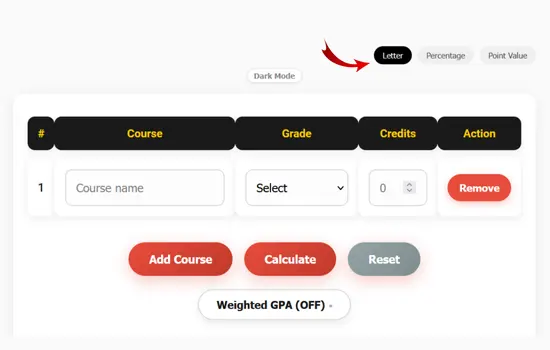
2. Add Your Course Name
Enter the course name for which you’re going to determine scores and credits.
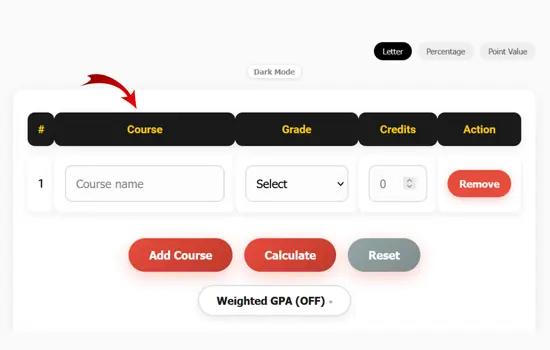
3. Add Your Grades
Enter your current grade in that particular class. If you don’t know the grades yet, select estimated ones for that subject.

4. Add Your Credits
Now enter your credits for that class. Remember here, credits are weights that every class has. As you learned, in a weighted grading system, every category has different weights, but in an unweighted system, all categories hold the same weights. So, put credits according to your school’s grading system.
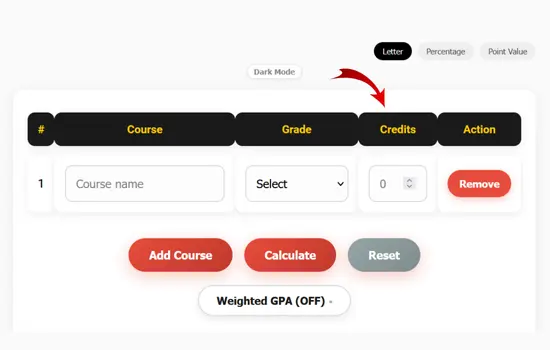
5. Add Extra Weighted Classes
If you’re having extra weight classes like AP or Honors. Then press the weighted GPA button to turn on this function for calculation and select the option accordingly. If you’re not taking AP or Honors classes, you can still use the weighted GPA function, but you will select regular for accurate calculation.
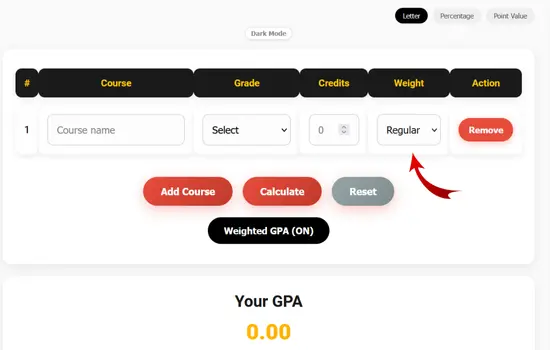
6. Calculate Your GPA
After entering all the inputs, click the calculate button and see your result in a few seconds. You can also add more courses by pressing the “Add Course” button and calculating the cumulative GPA.
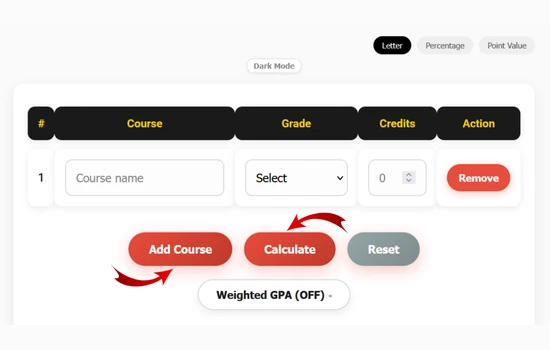
7. Save Your Academic Progress
After receiving your outcomes, click the download PDF button to download a PDF of your progress.
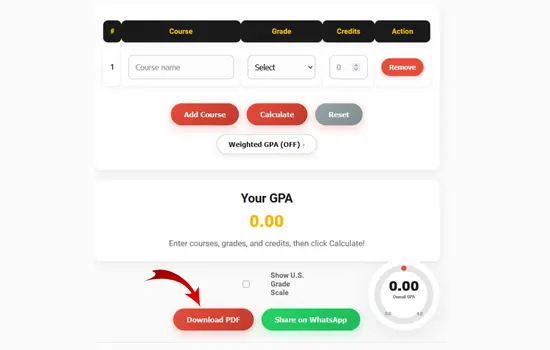
8. Share Your Academic Progress
If you want to share your academic progress with your friends, relatives, or loved ones. You can use the share on WhatsApp button to keep them posted regarding how you’re performing in high school.
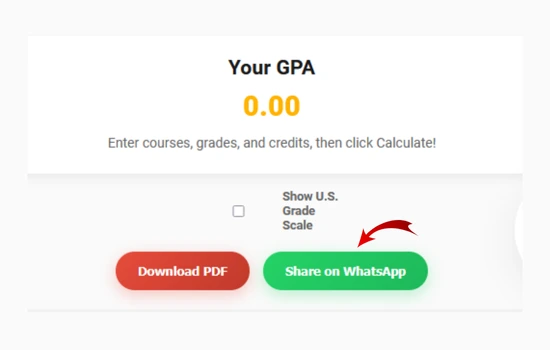
If you want to do this calculation manually, then check out our guide on how to calculate GPA in high school. This guide will help you to do all these calculations manually, step by step, along with grade conversion and examples.
GPA Calculation Formula
Behind all these calculations, there is a GPA calculation formula that works. It’s simple and easy to apply, whether you choose to calculate manually or use a tool. This formula looks something like this: GPA = (Grade Points × Credit Hours) ÷ Total Credit Hours. You can get quality points by multiplying each grade point value by the credits that particular class holds. For more understanding, see this example.
Suppose your bio class holds three credits, and you got an A (4.0) on the grading scale. And English class is four credits, but the grade in that class is B-, which is 2.7 on the scale. Now you need to multiply the bio credits (3) by the grade points (4.0), and it will look something like this: 3×4.0 = 12. And for the English class, you will multiply 4 (credits) by 2.7 (B grade), and the result will be 4×2.7 = 10.8.
Edge Cases in GPA Calculation
You will be surprised to know that all your classes will contribute to your GPA differently. So there will be some edge cases where the calculation will be slightly different due to these specific situations and their impacts. Take a look at the table below to see some edge cases and their impact on GPA:
| Grade Type | Situation | Impact on GPA |
|---|---|---|
| Pass/Fail Courses | Mostly passing courses will be added as credits towards graduation but not add up in GPA. | No impact on GPA |
| Withdrawals (W) | If you dropped some of the courses after your enrollment but before the completion of the semester. | It (W) will not affect your GPA, but withdraw fail (WF) could be counted as F in cumulative grade. In both cases it will be present on your transcript as a record. |
| Incomplete (I) | Incomplete (I): If your coursework is not completed by the end of the term, then you will be having temporary grades. | Temporary grades will not be added in GPA, so they cannot affect it, but after the temporary grade, there will be a final grade assigned upon completion of coursework, and those final grades will affect your total average. |
| Repeated Courses | If you will retake any specific course to improve your grades in it. | Some high schools will replace your old grades with new ones, but some will make an average by calculating both, but in both cases it will have an impact on your overall grade. |
| Transfer Credits | If you earned grades at another institution and those grades are countable | Those transferred grades will be counted towards your total credits but not in the cumulative average. |
| Audit Courses | If you have taken any course just for learning but not for earning credits. | It will not affect your overall average or points. |
| Remedial Courses | If you’re taking courses that are basic or preparatory that are below college level. | Some institutes will count them, but some will not count them in official GPA calculation. |
| Honors/AP Courses (weighted) | If you’re taking these advanced courses of different levels of difficulty. | These will greatly affect your cumulative average because these courses will add extra points in it (an A will be 5.0 in these instead of 4.0). |
| Credit/No Credit | If you’re taking courses in which you can earn credits without letter grades. | It will not have any impact on your total average directly. |
| Grade Replacement Policies | If you’re taking any course for which your institution will allow replacement of grades with low ones. | It can improve your GPA if your institution allows a replacement policy. |
It’s better to see your institution’s policies that they follow for GPA estimation.
GPA Scale
Most U.S. schools use the letter grading system. Some schools include A+, A-, B+, C-, etc., but some don’t. Some courses with a specific difficulty level carry more weight and can affect your GPA more. But our GPA calculator can accurately, efficiently, and authentically handle these differences.
4.0 GPA Scale
Most high schools use a standard 4.0 scale for overall average estimations. Consider it below for your consideration.
| Letter | Grade |
|---|---|
| A | 4.0 (Excellent) |
| B | 3.0 (Good) |
| C | 2.0 (Average) |
| D | 1.0 (Poor) |
| F | 0.0 (Fail) |
Common GPA Conversions
When most of the schools will use a 4.0 scale, but for AP or Honors they will use a weighted scale that will exceed 4.0. And some may use a 4.33 GPA scale. Our GPA calculator works for both of these scales. It comes with full functionality for all estimation.
Guidelines for raising GPA
In your academic journey, thinking about raising your GPA is good, but unfortunately, there is no fixed formula, recipe, or trick that can do this for you. Because not everything works for everyone, maybe any strategy will work for you, but not for your friend. We are not saying raising your GPA is not possible, but adopting different habits and strategies is worth trying, because any of them can indirectly impact your study routine, habits, or style, and, as a result, your GPA will improve. Remember, these guidelines are not fixed methods to save you from failure, but these are some of the things that worked for most people and positively impacted their study, and as a result, their GPA rose.
Actively attending classes
Many classes or subjects may seem like they’re not worth your time or they’re not according to your interest, but it’s a fact that all classes will impact your GPA more or less. So attending all classes will be beneficial for you because engaging in discussion and lectures will help you to get a better understanding of the subject’s concept, and as a result, it will improve your grades because you will be sitting in the examination hall with a better understanding of the course.
Planning and Study Habits
Planning your academic goals and adjusting your study habits can significantly increase your chances of achieving a higher overall average. When you plan your grades and track them, you understand which course needs your most effort and where you need to improve. And this awareness can help you divide your time based on your current progress and desired goals. So, keep a GPA calculator, set an alarm, and make a timetable, while keeping books and important notes near you at all times. Investing your time in understanding them is worth it for improving your GPA.
